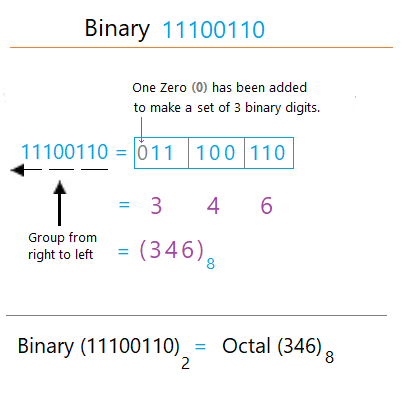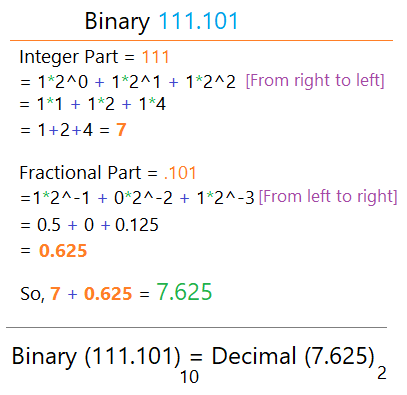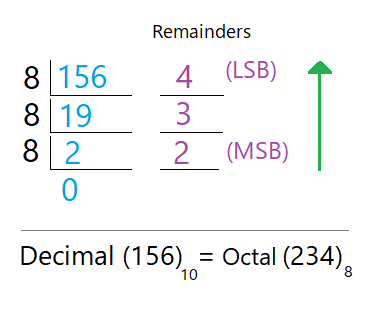Understanding Binary & Octal Number Systems:
Binary Number System
The binary number system, or base 2, is the digital language of computers and networks. It employs just two symbols: 0 and 1, representing "off" and "on." Binary numbers are the essence of computing and electronic communication.
The binary number "1100011" can be understood as follows:
- The first digit (the rightmost digit or LSB) (1) is in the one's place, equivalent to (1 * 1 = 1)
- The second digit (1) is in the two's place, equivalent to (1 * 2 = 2)
- The third digit (0) is in the four's place, equivalent to (0 * 4 = 0)
- The fourth digit (0) is in the eight's place, equivalent to (0 * 8 = 0)
- The fifth digit (0) is in the sixteenth place, equivalent to (0 * 16 = 0)
- The sixth digit (1) is in the thirty-second place, equivalent to (1 * 32 = 32)
- The seventh digit (the leftmost digit or MSB) (1) is in the sixty-fourth place, resulting in (1 * 64 = 64)
Adding the results produces = 1 + 2 + 0 + 0 + 0 + 32 + 64 = 99 .
Therefore, the binary number (1100011)2 is equal to the decimal value of (99)10.
Now we will examine another binary number that has a fractional part. For instance, 10010.0101. The binary number "10010.0101" has two parts. One is the integer part (e.g. 10010), and another part is the fractional part (e.g. .0101)
The integer part (10010) of the binary number can be understood as follows:
- The first digit (the rightmost digit) (0) in the one's place (0 * 1 = 0)
- The second digit (1) in the two's place (1 * 2 = 2)
- The third digit (0) is in the four's place (0 * 4 = 0)
- The fourth digit (0) is in the eight's place, (0 * 8 = 0)
- The fifth digit (the leftmost digit) (1) is in the sixteenth's place, (1 * 16 = 16)
Thus, the integer part of the binary number 10010 is equivalent to decimal number 0 + 2 + 0 + 0 + 16 = 18.
Secondly, the fractional part (0101) of the binary number can be understood as follows:
- The first digit after the decimal (0) in the 2-1 or 1/2th place (0 * 2-1 = 0 * 1/2 = 0)
- The second digit after the decimal (1) in the 2-2 or 1/4th place (1 * 2-2 = 1 * 1/4 = .25)
- The third digit after the decimal (0) in the 2-3 or 1/8th place (0 * 2-3 = 0 * 1/8 = 0)
- The fourth digit after the decimal (1) in the 2-4 or 1/16th place (1 * 2-4 = 0 * 1/16 = .0625)
Thus, the fractional binary part .0101 is equivalent to decimal number 0 +.25 + 0 + .0625 = 0.3125.
Therefore, the binary number (10010.0101)2 is equivalent to the decimal value of (18.3125)10.
The binary system is the foundation of data encoding in the digital world, vital for computer science and technology.
Octal Number System
The octal number system, also known as base 8, utilizes eight unique digits: 0, 1, 2, 3, 4, 5, 6, and 7. Each place value represents a power of eight, making it an interesting system for certain applications.
Please note that the octal number system does not have the digits 8 or 9. So, in the octal number system, after 7 comes 10 (much like the way 10 comes after 9 in the decimal number system).
Octal numbers are commonly used in various fields and have specific importance in certain contexts including Computer Programming, File Permission Management, ASCII Character Codes, Microcontroller Programming and so on. Moreover, In Unix and Unix-like operating systems, file permissions are often represented in octal notation.
Each digit in the octal representation corresponds to a different type of permission (read, write, and execute) for the owner, group, and others. For example, "755" represents read, write, and execute permissions for the owner and read and execute permissions for the group and others.
Let's examine an octal number, such as 3265 for a better understanding of this number system:
- The first digit (the rightmost digit or LSB) (5) is in the one's in (5 * 80 = 5 * 1 = 5)
- The second digit (6) is in the eight's place, resulting in (6 * 81 = 6 * 8 = 48)
- The third digit (2) is in the sixty-four's place, resulting in (2 * 82 = 2 * 64 = 128)
- The fourth digit (the leftmost digit or MSB) (3) is in the five hundred and twelfth place, resulting in (3 * 83 = 3 * 512 = 1536)
Thus, the octal number (3265)8 is equal to the decimal value of = 5 + 48 +128 + 1536 = (1717)10.
Octal numbers, like binary, can also have fractional parts. For example, 512.47, in which the integer part 512 translates to 330, and the fractional part .47 is 0.59375.
Let's examine this. The octal number "512.47" has two parts. The integer part (e.g. 512), and the fractional part (e.g. .47)
The integer part (512) of the octal number can be understood as follows:
- The first digit (the rightmost digit) (2) in the one's place (2 * 80 = 2 * 1 = 2)
- The second digit (1) in the eighth's place (1 * 81 = 1 * 8 = 8)
- The third digit (the leftmost digit) (5) is in the sixty-fourth place ( 5 * 82 = 5 * 64 = 320)
Thus, the integer part of the octal number 512 is equivalent to decimal number 2 + 8 + 320 = 330.
And, the fractional part (.47) of the octal number can be understood as follows:
- The first digit after the decimal (4) in the 8-1 or 1/8th place (4 * 8-1 = 4 * 1/8 = 0.5)
- The second digit after the decimal (7) in the 8-2 or 1/64th place (7 * 8-2 = 7 * 1/64 = 0.109375)
Thus, the fractional octal part .47 is equivalent to decimal number 0.5 + 0.109375 = 0.609375.
Therefore, the octal number (512.47)8 is equivalent to decimal value of (330.609375)10.
It's important to note that the octal system uses base 8, which is presented using radix or base 8, such as (3265)8. A decimal number like (1717)10 is typically not labelled with a base as decimal is the default number system that we use.


